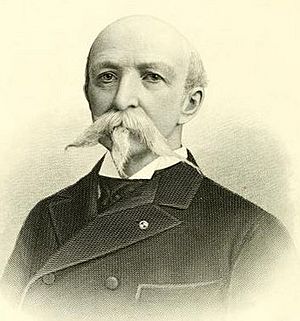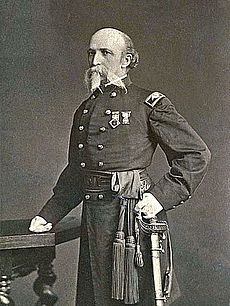John Mason Loomis facts for kids
Quick facts for kids
John Mason Loomis
|
|
|---|---|

1892
|
|
| Born | January 5, 1825 |
| Died | August 2, 1900 (aged 75) Chicago, Illinois, US
|
| Resting place | Rosehill Cemetery, Chicago |
| Nationality | American |
| Education | public schools |
| Occupation | businessman, lumberman, u.s. army colonel |
| Known for | developing Mason County and Ludington, Michigan |
| Signature | |
John Mason Loomis (born January 5, 1825 – died August 2, 1900) was an American businessman from the 1800s. He was known for his work in the lumber industry in Chicago. He also played a big part in helping to build the city of Ludington, Michigan.
Loomis was a Colonel in the Illinois militia. This group became part of the Union Army during the American Civil War. He fought in many important battles. John Mason Loomis was also a leader in helping others through charity work.
Contents
Early Life and Education
John Mason Loomis was born in Windsor, Connecticut, on January 5, 1825. His parents were Colonel James Loomis and Abigail Loomis. His family had English roots. His father was a farmer, merchant, and miller from Windsor. His mother came from a family known for many successful doctors.
As a child, John went to public schools in Connecticut. When he was a teenager, he worked in his father's store. This is where he first learned about business.
Business Career
In 1848, when he was 23, Loomis took over a lumber business in Milwaukee. This business did very well. In 1852, he moved the business to Chicago. He then teamed up with James Ludington from Milwaukee. Their partnership was called Loomis & Ludington.
Their business was successful until 1861. That year, Loomis joined the American Civil War as a colonel. He left the army in 1864 and came back to Chicago. He found that his lumber business had been badly managed and was ruined.
Since he still loved the lumber business, he became a commission merchant. This means he helped others buy and sell lumber. He was very good at this. Later, he became a partner with John McLaren. They formed a new company called John Mason Loomis & Company. For many years, his company on South Water Street was one of the top lumber firms in Chicago.
Developing Ludington
In 1869, Loomis became the treasurer of the Pere Marquette Lumber Company in Ludington. He worked hard with others in the company to move the main government offices for Mason County, Michigan, to Ludington. Before this, the county seat was in a village called Lincoln.
Loomis and another businessman, Delos L. Filer, promised $1,000 each. This money helped build a new county office building in Ludington. It was finished in 1874. Loomis became the president of the Pere Marquette Lumber Company in 1879.
Loomis also discovered something important about salt. He found that salty water from wells could be heated to make usable salt. The Pere Marquette Lumber Company was the first to burn leftover wood scraps to power these salt-making factories. Other local business owners copied Loomis's methods. Soon, a new salt industry grew in northwestern Michigan. The village of Pere Marquette grew thanks to these lumber and salt businesses. It eventually became the city of Ludington.
Military Service
Loomis became a Captain in the state militia when he was 18. He also became a Navy Midshipman. However, he got tired of waiting to be called into action. So, he joined the United States Merchant Marine. He traveled to places like India and returned to Chicago in 1845.
When the American Civil War started in 1861, Loomis was eager to join. He was already a first Lieutenant in the Chicago Light Guard. He was known as a dedicated and skilled military leader. Because of this, Governor Yates asked Loomis to lead a regiment in the war. Many important people in Chicago supported this request, and Loomis accepted. In August 1861, Loomis became the colonel of the 26th Illinois Infantry Regiment.
Loomis's regiment fought in many battles. These included the Battle of Island Number Ten, the Battle of Iuka, the Siege of Corinth, the Siege of Vicksburg, and the Battle of Jackson, Mississippi. They also fought in the Second Battle of Chattanooga and the Battle of Farmington, Tennessee.
Reports from the St. Louis Globe Democrat said he fought bravely. He rallied his men during the Second Battle of Chattanooga. He also led the 26th at the Battle of Missionary Ridge. One tribute called this a "remarkable achievement" for citizen soldiers.
Colonel Loomis hoped to become a Brigadier general. General Ulysses S. Grant recommended him twice for the position. However, he was never promoted. Loomis also served with the 16th Corps Support Group. During his time in the military, Colonel Loomis fought in 57 battles and skirmishes. He marched over 6,900 miles with his men. He left the army on April 30, 1864, because he was very tired. He went back to Chicago and became a successful real estate owner. He also worked hard to support other war veterans.
While Colonel Loomis was stationed in Missouri, his wife was with him on the front lines. She was in charge of a group of nurses.
Personal Life and Charity Work
John Mason Loomis's father, James Loomis, named his son after a famous officer. This officer was John Mason, who fought in the Indian Wars in New England in the 1600s. James admired Mason's military skills.
In 1849, John Mason Loomis married Mary Hunt. She was the daughter of Milo Hunt from Chenango County, New York.
John Mason Loomis, his three brothers, and one sister all lost their own children during their lives. Because of this, they decided to use their money to create the Loomis Institute. This institute would help educate young boys and girls. In 1874, they officially started the Loomis Institute, which became part of the Loomis Chaffee School. It is a boarding and day school in Windsor, Connecticut. For its first 40 years, it offered free education to students aged 12 to 20.
Loomis was on the board of directors for the Chicago Relief and Aid Society. This charity helped people who lost their homes and everything they owned after the Great Chicago Fire in 1871. He gave both money and his time to this and other charities for 20 years.
He was a strong believer in the Episcopalian church. He was very active and a big helper at Chicago's Grace Episcopal Church. In politics, Loomis was a strong Republican. While he wasn't a politician himself, he worked to help good people get elected to office.
Loomis helped start the George H. Thomas Post Number 5 of the Grand Army of the Republic. In 1879, Loomis also organized the Illinois Commandery of MOLLUS. This was the Military Order of the Loyal Legion of the United States. He became its commander in 1884, taking over from Philip Sheridan. Loomis served as Treasurer in 1879, head of the U.S. Volunteers from 1880 to 1883, and Commander in 1884.
Loomis retired in 1885. He built a home at 55 Lake Shore Drive in Chicago. He passed away in Chicago on August 2, 1900. He is buried at Rosehill Cemetery.
Legacy
In 1910, John Mason Loomis's wife left over $1.1 million. This money was given to the "Loomis Institute" to help with its charitable work.


